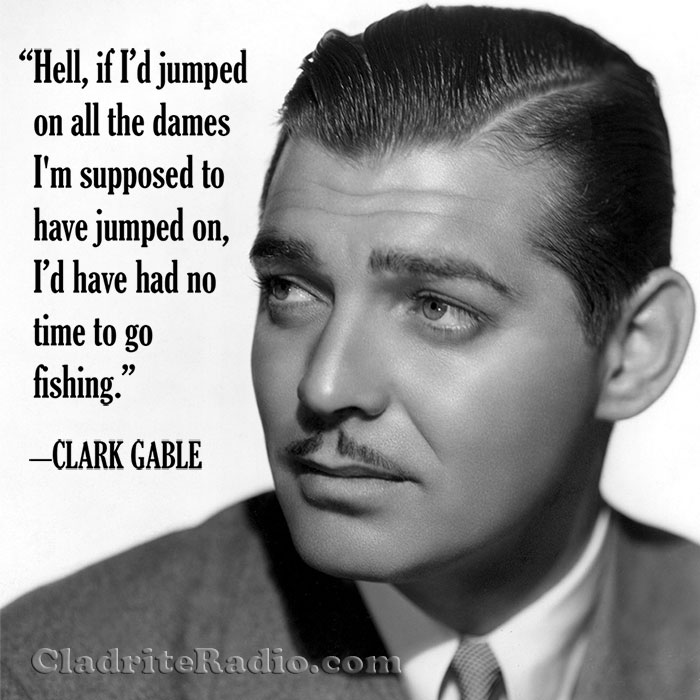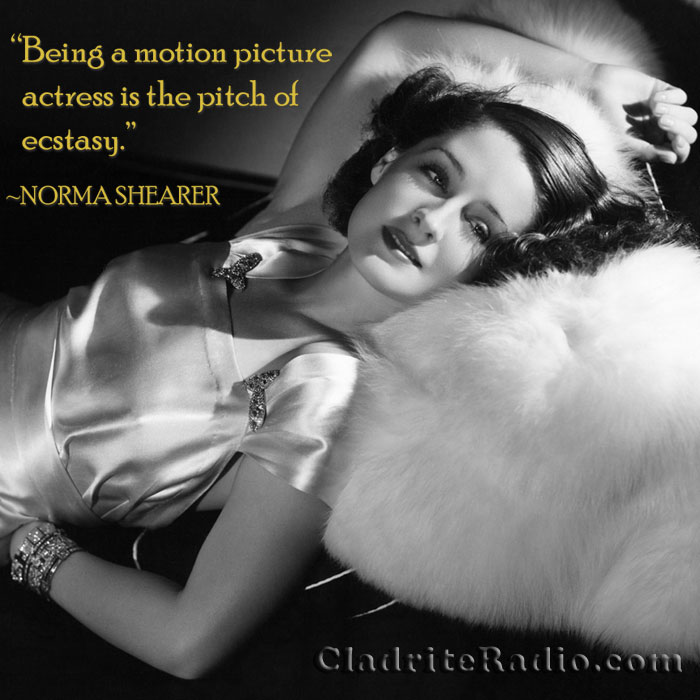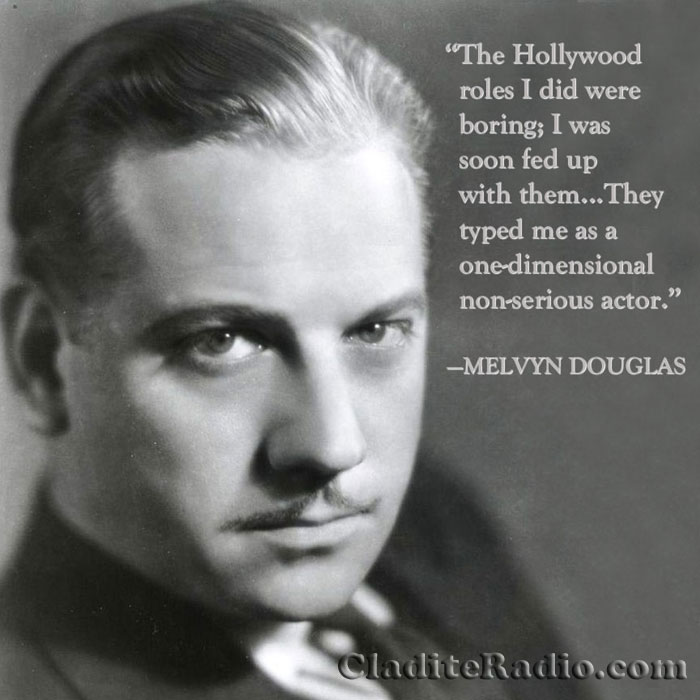Here are 10 things you should know about Marie Dressler was born—wait for it—152 years ago today. That she is still a prominent pop-cultural figure (at least among old-movie buffs) is a remarkable thing.
Tag: Norma Shearer
Happy 116th Birthday, Clark Gable!
Clark Gable was born William Clark Gable 116 years ago today in Cadiz, Ohio. In his day, he was known as the King of Hollywood or, often, just as the King. Here are 10 CG Did-You-Knows:
- Gable was named after his father, William, who was an oil well driller, but even as a child, he was referred to by his middle name or sometimes as Billy. His birth certificate mistakenly listed Gable as female.
- Gable’s stepmother (his birth mother died when he was young) encouraged his interest in music, teaching him to play piano. He later took up brass instruments and at age 13, he was the only teen to play in the men’s town band. Gable’s father encouraged him from an early age to be well-dressed and well-groomed.
- At 17, Gable decided he decided to pursue a career in the theatre and by 21, he was touring in stock companies, along with jobs in the oil fields and working with horses. Josephine Dillon, an acting coach and theatrical manager in Portland, Oregon, set out to remake Gable from head to toe. She paid for him to get new teeth, she built up his once-slight physique with a proper diet and strenuous exercise and helped him improve his movements and posture. She also worked at length to lower his high-pitched voice and improve his diction.
- Dillon, who was 17 years Gable’s senior, also financed Gable’s relocation from Portland to Hollywood in 1924, where she officially became his manager and his wife. He changed his professional name from W. C. Gable to Clark Gable and began to work as an extra and a bit player in silent short and features.
- When no leading film roles were in the offing, Gable returned to the stage, acting for a season with the Laskin Brothers Stock Company in Houston, Texas, where he played a variety of roles and gained valuable experience. Finally, with the ascent of talking pictures, Gable’s stock as an actor rose as well. He was offered a contract with MGM in 1930. His first role was as a rough-hewn villain in a William Boyd western, The Painted Desert (1930). His imposing stature and now-powerful speaking voice made a quick hit with moviegoers (especially female ones).
- Many of Gable’s early roles were tough guys, gangsters and villains, and though no less an authority than Darryl F. Zanuck had once said of Gable, “His ears are too big and he looks like an ape,” he was finding himself cast opposite popular leading ladies of the day, including Joan Crawford, Barbara Stanwyck, Norma Shearer and even Greta Garbo (with whom he shared a mutual dislike—she thought his acting wooden; he thought her a snob).
- Despite long being known as the King of Hollywood, Gable was never No 1 at the box office in a given year, but year after year, he ranked near the top, as the fortunes of other actors rose and fell. His breakthrough role was his Oscar-winning performance in Frank Capra‘s It Happened One Night in 1934, opposite Claudette Colbert. That classic film won the Best Picture Oscar to go along with Gable’s Best Actor nod. Capra considered the role of Peter Warne in the film the closest to Gable’s actual personality: “It Happened One Night is the real Gable,” he wrote. “He was never able to play that kind of character except in that one film. They had him playing these big, huff-and-puff he-man lovers, but he was not that kind of guy. He was a down-to-earth guy, he loved everything, he got down with the common people. He didn’t want to play those big lover parts; he just wanted to play Clark Gable, the way he was in It Happened One Night, and it’s too bad they didn’t let him keep up with that.”
- Gable is said to have been Adolph Hitler‘s favorite actor, and it’s been reported that Hitler offered a reward to anyone who could capture Gable, then flying combat missions over Germany, and bring him to Hitler unharmed. The reward went unclaimed.
- Gable played a newspaper reporter in nine different pictures, more than any other type of role, but late in life, he expressed regret that he hadn’t appeared in more westerns, the genre he most enjoyed working in.
- Gable was married five times, the first two times to women many years his senior, but it is generally accepted that his third Wife, actress Carole Lombard, was the great love of his life. She even got Gable, a lifelong Republican, to support Franklin Delano Roosevelt for president. It’s said that Lombard’s tragic death in a plane crash in 1942 left Gable so bereft that he immediately enlisted in the Army Air Corps and was absent from the silver screen for three years.
Happy birthday, Clark Gable, wherever you may be!

Happy 148th Birthday, Marie Dressler!
Beloved character actress and comedian Marie Dressler was born Leila Marie Koerber 148 years ago today in Cobourg, Ontario. Here are 10 MD Did-You-Knows:
- Dressler’s father was a music teacher and her mother a musician. When she was still a child, her family moved to the United States, residing in Michigan and Ohio. She grew appearing in amateur theatricals.
- At 14, Dressler left home, lying about her age that she might join a traveling stock company that played mostly in the Midwest. Her older sister, Bonita, also worked with the stock company for a time before leaving to get married. Much of Dressler’s early stage work was in light opera.
- Dressler made her Broadway debut in 1892 in Waldemar, the Robber of the Rhine, a production that enjoyed a brief five-week run. Dressler, who stood 5′ 7″ and weighed 200 pounds, had dreamed of being an operatic diva or a tragedienne, but the author of Waldemar, Maurice Barrymore, father to Lionel, John and Ethel, convinced her that comedic roles would suit her best.
- Dressler’s first starring role came in 1896 in The Lady Slaver, which played for two years at the Casino Theatre.
- Throughout the 1900s and ’10, Dressler kept busy in Broadway productions and in vaudeville, and during World War I, she toured the country, selling Liberty bonds and entertaining the troops.
- Aside from cameo roles playing herself in a pair of film shorts, Dressler’s movie debut came in 1914 at age 44 when fellow Canadian Mack Sennett hired her to star opposite Charlie Chaplin (in a villainous, non-Tramp role) in Tillie’s Punctured Romance, one of the first full-length, six-reel motion picture comedies. The movie was a hit, and Dressler continued to enjoy success in film comedies into the 1920s.
- Her movie career on the wane in the late ’20s, Dressler, now in her late 50s, was considering taking a position as a housekeeper on Long Island—another story has it that she was on the verge of committing suicide—when screenwriter Frances Marion convinced MGM to cast her in The Callahans and the Murphys (1927). That hit picture revived her career.
- Dressler won the Best Actress Oscar for Min and Bill (1930), the first of three popular pictures she would make with Wallace Beery. Only the fourth actress to win that award, she was the third Canadian in a role to do so (after Mary Pickford and Norma Shearer). She received the award the day after her 63rd birthday.
- At age 65, Dressler was named the top box-office draw of 1933 by the Motion Picture Herald.
- The house Dressler was born in Cobourg still stands. Known today as the Marie Dressler House, it was a restaurant from 1937 through 1989, when it was damaged by fire. After being restored, it served as the office for the Cobourg Chamber of Commerce for a time until it was transoformed into a Marie Dressler museum and information center for tourists visiting Cobourg.
Happy birthday, Marie Dressler, wherever you may be!

Happy 114th Birthday, Norma Shearer!
There seems to be widespread confusion regarding Norma Shearer’s birthday. Some sources say she was born on August 10, some say August 11, and The New York Times, in its obituary for her, cites August 15. The year is in question too: Was she born in 1900, 1902 or 1904? Biography.com lists her birth as occurring in 1900 and 1902.
We’re going with August 10, 1900, but we cannot promise that’s correct….
Norma Shearer was born Edith Norma Shearer 114 years ago today in Montréal, Québec, Canada. Here are 10 Did-You-Knows about the former Queen of MGM:
- Shearer, who won a beauty contest at 14, moved to NYC with her (stage) mother and sister Athole (who would later marry legendary director Howard Hawks) four years later. After Florenz Ziegfeld passed on casting Shearer in his Follies, she got some small roles in movies.
- Irving Thalberg saw some of her early movie work and in 1923 signed Shearer to a contract with with Louis B. Mayer Pictures, a precursor of MGM, where he was vice-president.
- Shearer made eight—count ’em, 8!—feature pictures in 1924.
- Shearer converted to Judaism to marry Thalberg in 1927 and continued to observe the faith after his death and for the rest of her life.
- Norma’s brother, Douglas, won twelve Academy Awards for his work as a sound designer. The pair were the first brother-and-sister tandem to win Oscars.
- At a point in her career when she appeared in only prestige productions, she played a part in The Stolen Jools (1931), a star-studded short subject intended to raise money for a tuberculosis sanatorium, as the owner of the titular “jools.” Also in the film were such luminaries as Wallace Beery, Buster Keaton, Edward G. Robinson, Laurel and Hardy, and members of the Our Gang cast.
- F. Scott Fitzgerald is said to have based one of his stories, “Crazy Sunday,” on one of Shearer’s parties and the story’s protagonist, Stella Calman, on Shearer herself.
- Weak eye muscles gave Shearer a slightly crossed eye; she worked with eye doctors to improve it and cameramen to disguise it.
- She was the third woman to win the Best Actress Oscar and the second of three consecutive Canadians to win it (Mary Pickford won it in 1929 and Marie Dressler in 1931).
- Among the roles she is reported to have turned down were Scarlett O’Hara (Gone with the Wind), Mrs. Miniver, and Norma Desmond (Sunset Boulevard). Of Scarlett, she said, “Scarlett O’Hara is going to be a thankless and difficult role. The part I’d like to play is Rhett Butler.”
Happy birthday, Norma Shearer, wherever you may be!

Happy 115th Birthday, Melvyn Douglas!
Melvyn Douglas, born Melvyn Edouard Hesselberg 115 years ago today in Macon, Georgia, was the product of an unlikely marital pairing: His father was a Latvian Jewish immigrant, a concert pianist who taught music in university conservatories, and his mother was from Tennessee (with English ancestry that extended back to the Mayflower). Douglas’s father never mentioned he was Jewish and his mother referred to him in her son’s presence as simply as “foreign.” So Douglas didn’t know of his Jewish heritage until he was 18 years old, when his aunt Cora clued him in.
Douglas dropped out of high school to pursue a career in theatre, and he found success on Broadway (in 1928, he played the same role, a gangster, in the drama A Free Soul that Clark Gable would play in the 1931 movie adaptation opposite Norma Shearer). In 1932, Douglas answered Hollywood’s call and though his ensuing screen career was a successful one, it would be some years before he found satisfaction in motion pictures.
“The Hollywood roles I did were boring,” said Douglas, perhaps best remembered today as the man who made Greta Garbo laugh in Ernst Lubitsch‘s classic comedy, Ninotchka. “I was soon fed up with them. It’s true they gave me a world-wide reputation I could trade on, but they also typed me as a one-dimensional, non-serious actor.”

In the early ’60s, his leading man days behind him (and the iron grip of the studio system loosened), Melvyn Douglas began to find work as a character actor, and it was only then that he had the free reign he sought in choosing roles. “I do a picture only because I want to do it, for my own reasons,” he said at the time. “If it’s a lemon, at least I picked it.”
Douglas achieved the rare triple threat for an actor: He won an Oscar (two, actually, for Best Supporting Actor, in Hud [1963] and Being There [1979], an Emmy (Best Actor-Drama for a 1967 CBS Playhouse production entitled Do Not Go Gentle into That Good Night) and a Tony (Best Actor-Play, The Best Man [1960]). Douglas died in 1981 at the age of 80.
Happy birthday, Mr. Douglas, wherever you may be! We quite liked your work in those pictures of the 1930s and ’40s, but we’re glad you got to expand your range a bit before you were through.
